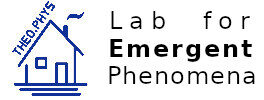PhD Thesis – Miriam Martinsons
Miriam Martinsons
Phasonic Degrees of Freedom in Quasicrystals [PDF]
finished 2019-08
supervised by Michael Schmiedeberg
Abstract
Quasicrystals are remarkable ordered structures without periodic translational symmetry. They can possess any discrete rotational symmetry including those that must not be present in periodic crystals. An important characteristic of quasicrystals is the existence of additional degrees of freedom whose excitations lead to rearrangements of particles. Such rearrangements are called phasonic flips. Several material properties like the elasticity of quasicrystals are affected by phasonic excitations. By now, quasicrystals have been synthesized in experiments and simulations and have even been found in nature. The aim of this thesis is to contribute to the understanding of the amazing order and properties of quasicrystals. For this purpose we employ computational simulations of two-dimensional colloidal model systems where mesoscopic particles are suspended in a liquid. By implementing appropriate external or internal interactions quasicrystalline order of the colloids can be induced.
Significant new insights into the structural and dynamical complexity of quasicrystals are gained. Our results are essentially different from what is known from periodic crystals. In particular, investigations of the phase behavior of quasicrystals reveal a surprisingly rich phase diagram. Even in the solid, positional order is short-ranged due to excited phasonic degrees of freedom, and the transition to liquid is of first order. Furthermore, we illustrate how the growth of quasicrystals is affected by thermodynamic parameters and phasonic flips.
Especially the growth of nearly defect-free quasicrystals is presented. In addition, we focus on the dynamics of quasicrystals. The stability of quasicrystals against phasonic perturbations is investigated. Particles are identified which easily perform phasonic flips, while other ones are rather stable. Phasonic drifts lead to complex trajectories of the particles. Even in intrinsic quasicrystals, which form under internal interactions alone, correlated phasonic flips are found and analyzed.
Our work provides significant progress in theory and simulations of quasicrystals and our results obtained from colloidal model systems are also relevant for other fields in physics, chemistry and material science. We expect that our work motivates further theoretical and experimental research on quasicrystals and might also advance the design of novel applications based on quasicrystals.
